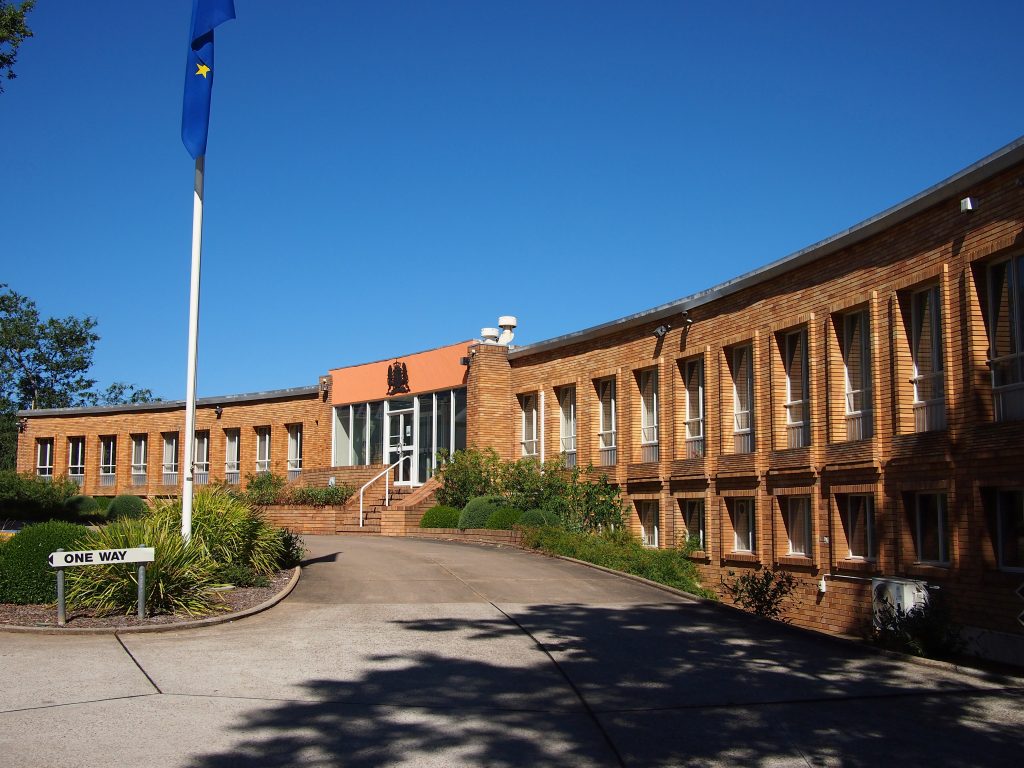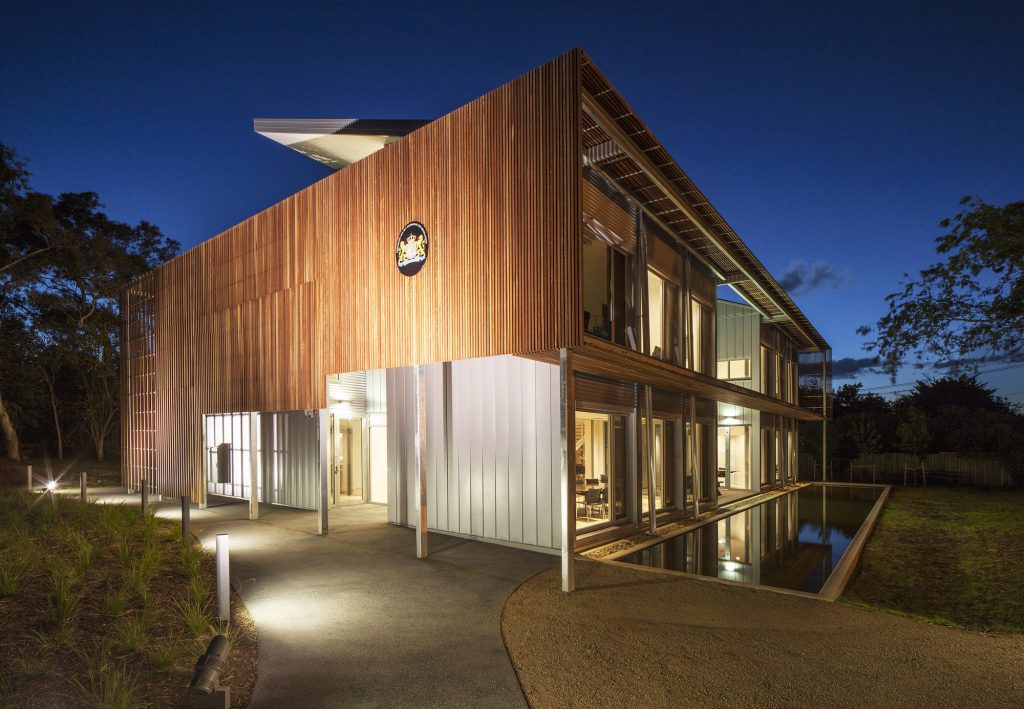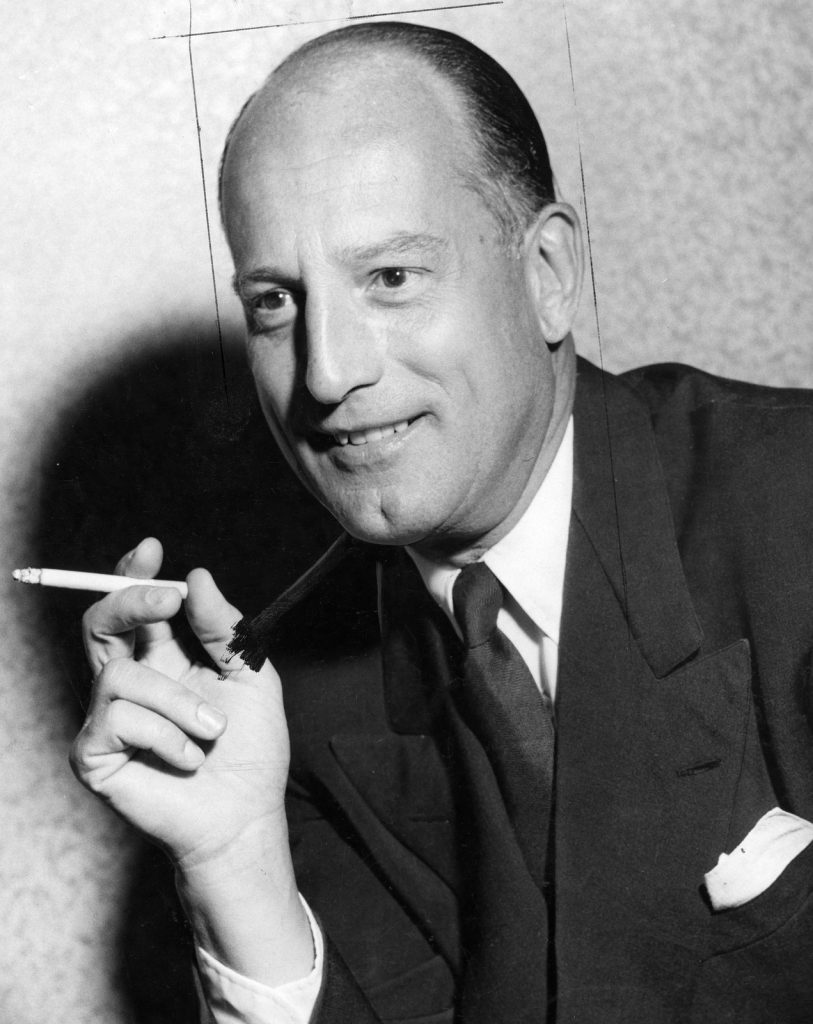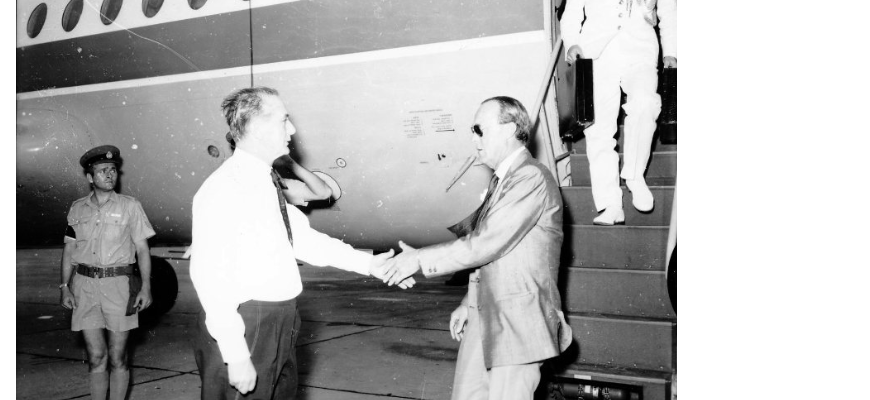Pierre van der Eng, Australian National University (updated January 2022)
It took until 1951 for The Netherlands to establish diplomatic representation in Australia in the form of an accredited ambassador. Depending on the issue, bilateral diplomatic matters were dealt with through the Dutch embassy in London until the 1940s, either through British public service mediation and/or through the Australian High Commission in London. Other issues, such as those related to trade and migration were since the 1850s largely dealt with by a growing number of consuls in the capital cities of the Australian colonies and states.[1]
1853-1889: trial-and-error, honorary consuls
In 1853, Frederick George Lange arrived in Melbourne with his brothers in law, Jan Willem and Daniel Ploos van Amstel, both scions of a reputable merchant family in Amsterdam.[2] Together they established a trading and shipping agency.[3] Lange became known in Melbourne as the honorary consul for the Netherlands.[4] After the colonies of Australia had acknowledged the 1856 convention between The Netherlands and Great Britain to exchange consuls, the Dutch government appointed the merchant Georg(e) Köhler, originally of Rotterdam, as its first honorary consul for New South Wales (NSW) in 1856.[5] His company specialised in imports from the Netherlands East Indies.[6] Appointments of honorary consuls in other cities in Australia followed. Since 1861, Köhler was also consul for the city state of Hamburg.[7]
To create hierarchy, the consuls in Sydney and Melbourne were both appointed as Consul General in 1863 for respectively NSW and Victoria.[8] Three years later, in 1866, the Consul General for NSW was appointed Consul General for ‘all British colonies in Australia, New Zealand and Tasmania’.[9] A succession of honorary appointments of consuls and consuls general followed in later years, as Table 1 shows.
The work of the consuls increased as trade relations between Australia and the Netherlands East Indies expanded.[10] Direct bilateral trade with the Netherlands remained marginal, as most was transhipped through British ports. Consuls responded to requests by Australian and Dutch authorities or private firms for information. They also recorded movements of Dutch ships in and out of local ports and the cargo they carried, reported on economic development in the Australian colonies, translated and legalised Dutch official documents, traced heirs of legacies in Australia, and represented the interests of the Netherlands East Indies as a neighbouring country of Australia. Most consuls were shipping agents and had their own trading companies. They had a direct interest in stable trade relations between Australia and The Netherlands or Netherlands East Indies.
In return for their services, honorary consuls benefited from their status and reputation. This gave them access to public authorities and to information that could advance their business interests. They were also allowed to charge set fees for their consular services and consul generals also received an allowance to cover their costs.[11]
The Anglo-Dutch trade agreement of 1824, and especially the renegotiated agreement of 1871, which lowered bilateral tariffs, had a significant impact on bilateral trade relations. Particularly, because both agreements also applied to the colonies of Australia and the Netherlands East Indies. After the 1860s, consuls and consuls general were under instructions to collect information about economic development in Australia. Their annual reports were summarized in newspapers and allowed traders in the Netherlands and especially the Netherlands East Indies to identify trade opportunities. Trade between Australia and colonial Indonesia improved during the second half of the century, with sugar, tea and coffee from Java reaching Australian ports.
Selecting honorary consuls seems to have been a hit and miss process in the 1850s and 1860s. The Dutch government had actually appointed Lange as ‘commercial agent’, not as honorary consul. His task was to mediate on behalf of the Dutch government in commercial issues. However, he advertised himself as ‘consular agent’ and was known in Melbourne as the Dutch consul. In 1855 he allegedly charged fees for his services in excess of the rates set by the Dutch government.[12]
When Lange in Melbourne accepted an appointment as consul for Turkey in 1857[13], the Dutch government appointed the 21-year old Melbourne-based German merchant and shipping agent Hugo von (der) Nahmer as honorary consul. In his enthusiasm, Von Nahmer started using the Dutch name Van der Nahmer to suit the appointment.[14] Nevertheless, he had to resign two years later when bankruptcy procedures were started against his company.[15]
In Sydney, Consul Köhler had appointed his business partner Jacobus Corneli(u)s ‘James’ Prost (also originally from Rotterdam) as vice consul.[16] Prost was subsequently appointed Köhler’s successor as consul in 1865, until he had to resign only a year later when he and the company were subjected to legal proceedings for malversation and insolvency.[17]
The selection of honorary consuls and vice consuls was also hit and miss, in terms of the time they invested in promoting the interest of the Netherlands in Australia. Some were very active in the local societies and business associations in the cities where they were located, and thus leveraged their honorary status, others not so.
1889-1941: professional consuls
As relations between Australia, The Netherlands and the Netherlands Indies intensified, the honorary consuls experienced that they required the services of salaried consular officials who could undertake the growing day-to-day activities under their supervision. The Dutch Ministry of Foreign Affairs dispatched professional consular staff to Australia to act as vice consuls. The first senior professional salaried appointee as Consul General in Melbourne in 1889 was Joan Adriaan de Vicq.[18] In Sydney, the first professional appointment was Hendrik Jacob Willem Huber. He who took over the running of the Sydney Consulate as a vice-consul in 1913, and was appointed as consul a year later.[19]
Following the resignation of Consul General Willem Lodewijk Bosschart in Melbourne in 1921, Consul Petrus Ephrem ‘Peter’ Teppema in Sydney became Consul General.[20] With his appointment, the position moved to Sydney until the 1940s, only to return to Melbourne in 1953 when long-serving honorary Consul Ferdinand Henry Wright was promoted to it. But by then diplomatic seniority had shifted to the ambassador in Canberra.
After the start of World War II in 1939, the Dutch government proposed in 1940 to upgrade the bilateral relationship and appoint and exchange diplomatic envoys.[21] The Australian government was initially reluctant. But when Australia’s economic relations with the Netherlands East Indies increased during 1940-1941, and when the threat of Japan in Southeast Asia became more ominous during 1941 and Australian armed forces became involved in the defence of the Netherlands East Indies, Australia agreed to proceed.
1941-now: envoys and ambassadors
The Dutch legation was formally established in November 1941, but the Australian government disagreed with a Dutch proposal to upgrade the position of Consul General Tom Elink Schuurman to that of Envoy and Minister of The Netherlands to Australia. The Australian government objected on the ground of Elink Schuurman’s allegedly cordial relations with German and Japanese colleagues during pre-war years.[22] The Dutch government appointed Elink Schuurman as Consul General in New York,[23] and its ambassador in Iran, Baron Francois Cornelis van Aerssen Beijeren van Voshol, as the first Envoy, Minister and Consul General of The Netherlands to Australia.[24]
Van Aerssen arrived in Canberra in April 1942.[25] He spent most of his time unofficially in Melbourne until the new legation building in Canberra was completed.[26] Before colonial Indonesia’s surrender to the Japanese, part of the Netherlands East Indies government had withdrawn to Australia, where it established the Netherlands East Indies Commission for Australia and New Zealand in Melbourne, effectively a government in exile.[27] Van Aerssen’s services were therefore mainly required in Melbourne.
The legation and envoy’s residence were located in 16 Mugga Way in the Red Hill suburb of Canberra; a residential villa purchased from senior Australian public servant Sir George Knowles.[28] The ambassador’s residence is today still located in the house. It took until 1955 before a separate embassy building was opened on 120 Empire Circuit in Yarralumla.[29] The first accredited Dutch ambassador appointed to Australia was Pedro Désiré Edouard Teixeira de Mattos in 1951.[30]
Until the formal transfer of sovereignty from The Netherlands to Indonesia in December 1949, the Dutch envoy also represented the interests in Australia of the colonial government in Indonesia, and he represented the interests of Dutch New Guinea until it came under UN administration in 1962. During 1943-1962, the legation and embassy were hives of diplomatic activity, as the governments of Australia and The Netherlands communicated and/or cooperated in various ways in relation to the Japanese occupation of Indonesia during 1942-1945, the Indonesian war of independence during 1945-1949, and the status of Dutch New Guinea during 1952-1962.
Other issues, such as migration from The Netherlands to Australia and issues of trade and investment by Dutch and Australian companies were largely delegated to the professional and honorary Dutch consuls located in the capital cities of the Australian states, particularly in Adelaide, Brisbane, Hobart, Melbourne, Perth and Sydney. From the 1960s onwards, trade policy and other economic policy issues were increasingly dealt with by the representations of the European Commission and later the European Union in Canberra.
After Dutch New Guinea came under UN administration in 1962, diplomatic activity at the Dutch embassy in Canberra entered calmer waters, also because migration from The Netherlands to Australia slowed to a trickle and Australia-Netherlands relations remained very cordial. Consequently, there were few bilateral issues that required intensive diplomatic attention. The Dutch ambassador was given the additional responsibilities of maintaining diplomatic relations with neighbouring countries after they gained independence, specifically Nauru (1968), Papua New Guinea (1975), Solomon Islands (1978) and Vanuatu (1980). But the establishment of a Dutch consulate in Port Moresby, and relatively marginal Dutch relations with the other 3 countries limited the duties required of Dutch ambassadors and their staff in Canberra.
Until 2012, postings of Dutch ambassadors to Canberra became increasingly an opportunity for seasoned Dutch diplomats to prepare for retirement at the age of 65. Among others, they maintained contacts with the communities of ageing Dutch migrants across Australia, were involved in celebrations of long-term Australia-Netherlands relations, hosted visits by members of the Dutch royal family and by Dutch ministers and occasionally the Dutch Prime Minister, and took care of relatively routine issues such as bilateral agreements on e.g. shipping and communications.
After a long sequence of male consuls and ambassadors, three female ambassadors represented The Netherlands in Canberra since 2012.



| From | To | Positions, names | |
| Consuls and Consuls-General in Melbourne | |||
| 1854 | 1857 | Frederick George Lange (1831-?, Honorary Consul) | |
| 1857 | 1859 | Hugo von (van der) Nahmer (1835-1878, Honorary Consul) | |
| 1859 | 1878 | Jan Willem Ploos van Amstel (1827-1878, Honorary Consul, since 1863 Honorary Consul General) | |
| 1878 | 1889 | Daniel Ploos van Amstel (1832-1890, Honorary Consul General) | |
| 1889 | 1895 | Dr Mr Joan Adriaan de Vicq (1857-1899, Consul General) | |
| 1895 | 1896 | Oscar Joseph Francis van Assche (1857-1926, honorary interim Consul General) | |
| 1896 | 1900 | Jhr Johann Christian Thubalkain Reelfs (1843-1925, Consul General) | |
| 1900 | 1921 | Willem Lodewijk Bosschart (1859-1924, Consul General) | |
| 1922 | 1924 | Jhr Mr Petrus Adrianus van Buttingha Wichers (1889-1953, Consul) | |
| 1924 | 1955 | Captain (later Lieutenant-Colonel and Colonel) Ferdinand Henry Wright (1888-1953, Honorary Consul, 1953-1981 Honorary Consul General) | |
Consuls and Consuls-General in Sydney | |||
| 1856 | 1865 | George Köhler (?-?, Honorary Consul, since 1863 Honorary Consul General) | |
| 1865 | 1866 | Jacobus Cornelius (James) Prost (?-?, Honorary Consul General) | |
| 1866 | 1886 | Francis MacNab (?-1886, Honorary Consul) | |
| 1887 | 1892 | Alexander Gray (?-?, Honorary Consul) | |
| 1893 | 1896 | Aart van Rijn van Alkemade (1854-1946, Honorary Consul) | |
| 1897 | 1900 | Mahlon C. Cowlishaw (1844-1900, Honorary Consul) | |
| 1900 | 1901 | Nicolaas Hendrik (Nicholas Henry) Paling (1861-1936, honorary interim Consul) | |
| 1901 | 1913 | Edmund Resch (1847-1923, Honorary Consul) | |
| 1914 | 1920 | Hendrik Jacob Willem Huber (1879-1950, Consul) | |
| 1920 | 1932 | Petrus Ephrem (Peter) Teppema (1890-1922, Consul, 1922-1960, Consul General) | |
| 1932 | 1935 | Paul Staal (1881-1967, Consul General) | |
| 1935 | 1942 | Tom Elink Schuurman (1901-1979, Consul General) | |
| Envoys, Ministers, Ambassadors in Canberra | |||
| 1942 | 1947 | Baron Francois Cornelis van Aerssen Beijeren van Voshol (1883-1968) | |
| 1947 | 1950 | Petrus Ephrem (Peter) Teppema (1890-1960) | |
| 1950 | 1953 | Jhr Dr Mr Pedro Désiré Edouard Teixeira de Mattos (1898-1978) | |
| 1953 | 1957 | Antonius Maria Laurentius (Anton) Winkelman (1891-1960) | |
| 1957 | 1960 | Antonius Hermanus Johannes (Tony) Lovink (1902-1995) | |
| 1960 | 1963 | Dr Jacobus Gijsbertus (Co) de Beus (1909-1991) | |
| 1963 | 1966 | Tom Elink Schuurman (1901-1979) | |
| 1967 | 1968 | Jhr Johan Quirijn Bas Backer (1906-1985) | |
| 1968 | 1972 | Dr Mr Willem Gustaaf Zeylstra (1913-1986) | |
| 1972 | 1976 | Rudolf Carl (Ruud) Pekelharing (1915-2000) | |
| 1976 | 1977 | Baron Albrecht Nicolaas van Aerssen Beijeren van Voshol (1922-1977) | |
| 1977 | 1983 | Mr Emile Louis Constant Schiff (1918-2007) | |
| 1983 | 1986 | Mr Cornelis Hendrik Adriaan (Cor) Plug (1929- ) | |
| 1986 | 1990 | Mr Joris Michael Vos (1940- ) | |
| 1990 | 1991 | Mr Jan Herman Robert Dudley van Roijen (1936- ) | |
| 1991 | 1995 | Mr Joan Cornelis Thade (Cees) Bast (1936-2001) | |
| 1995 | 1998 | Roelof Reinhold Smit (1940- ) | |
| 1998 | 2001 | Albertus Jozef Alphonsus Maria (Albert) Nooij (1937- ) | |
| 2001 | 2005 | Dr Henricus Hermanus Maria (Hans) Sondaal (1941- ) | |
| 2006 | 2009 | Niek Peter van Zutphen (1947- ) | |
| 2009 | 2012 | Cornelis Wilhelmus (Willem) Andreae (1947- ) | |
| 2012 | 2016 | Johanna Gerarda Maria (Annemieke) Ruigrok (1959- ) | |
| 2016 | 2019 | Erica Schouten (1963- ) | |
| 2019 | Marion Derckx |
References
CAS 874 (2008) 2.05.145 – Inventaris van de archieven van de Nederlandse Ambassade en de Consulaten in Australië en de Permanente Vertegenwoordiger bij de South Pacific Commission, 1955-1974 [Inventory of the archives of the Dutch embassy and the Dutch consulates in Australia and of the Permanent Representative to the South Pacific Commission]. The Hague: Nationaal Archief.
De Muy-Fleurke, Hélène J. and Plantinga, Sierk (1998) ‘Hulp in het buitenland: De consulaire dienst’ [Assistance overseas: The consular service] in Reina E. van Ditzhuyzen et al. (eds.) Tweehonderd jaar Ministerie van Buitenlandse Zaken [Two hundred years of the Ministry of Foreign Affairs] (The Hague: SDU) 124-142.
Ford, Jack M. (1996) Allies in a bind: Australia and the Netherlands East Indies in the Second World War. Loganholme: Australian Netherlands Ex-Servicemen and Women’s Association, Queensland Branch.
Krabbendam, Hans (2004) ‘Consuls and citizens: Dutch diplomatic representation in American cities 1800-1940’, in Robert P. Swierenga, Donald Sinnema and Hans Krabbendam (eds.) The Dutch in Urban America. (Holland, MI: Joint Archives of Holland and Hope College) 59-75.
Lasee, G.J. (1993a) 2.05.48.14 – Inventaris van het archief van het Nederlandse Consulaat-Generaal te Sydney, (1927) 1930-1954 [Inventory of the archive of the Dutch Consulate General in Sydney]. The Hague: Nationaal Archief.
Lasee, G.J. (1993b) 2.05.48.13 – Inventaris van het archief van het Nederlandse Consulaat-Generaal te Melbourne, (1928) 1930-1954 [Inventory of the archive of the Dutch Consulate General in Melbourne]. The Hague: Nationaal Archief.
Lasee, G.J. (1993c) 2.05.50.02 – Inventaris van het archief van het Nederlandse Gezantschap / Ambassade in Australië (Canberra), (1940) 1942-1954 [Inventory of the archive of the Dutch legation / embassy in Australia (Canberra)]. The Hague: Nationaal Archief. Tamse, Coenraad Arnold (1981) ‘The Netherlands Consular Service and the Dutch Consular Reports of the Nineteenth and Twentieth Centuries’, Business History, 23(3) 271-276.
Footnotes:
[1] Lasee 1993ab.
[2] http://www.archiefploosvanamstel.nl/index_bestanden/Page1393.html
[3] The Argus, 20 May 1853, p.10 and 15 August 1853, p.4; http://www.auspostalhistory.com/articles/1045.php
[4] The Argus, 24 August 1853, p.6 and 8 July 1855, p.4.
[5] Sydney Morning Herald, 26 August 1856, p.3; Bijlagen der Handelingen van de Staten-Generaal 1856-57, p.286-6. Köhler was the son of the Consul of Bavaria in Rotterdam.
[6] Empire, 3 March 1855, p.12; Sydney Morning Herald, 1 April 1857, p.2.
[7] Gentleman’s Magazine (November 1861) vol.211, p.554.
[8] Nederlandsche Staatscourant, 14 May 1863 and 27 September 1863.
[9] Nederlandsche Staatscourant, 24 June 1866.
[10] See Tamse (1981), De Muy-Fleurke and Plantinga (1988) and Krabbendam (2004) for overviews of the development of the foreign consular service of The Netherlands.
[11] In 1887 the allowance was just ƒ1,200. Nederlandsche Staatscourant, 17 August 1887.
[12] Handelingen van de Tweede Kamer der Staten Generaal, 20 November 1855, pp.121-122; Handelingen van de Eerste Kamer der Staten Generaal, 28 December 1855, pp.78-79.
[13] The Argus, 21 April 1857, p.7.
[14] Nederlandsche Staatscourant, 29 January 1857; The Age, 25 July 1857, p.4.
[15] Victoria Government Gazette No.131, 16 August 1859, p.1; The Argus, 29 July 1859, p.6, 4 February 1860, p.6, 30 March 1860, p.5 and 23 August 1861, p.6.
[16] Sydney Morning Herald, 1 April 1857, p.2.
[17] Sydney Morning Herald, 22 May 1866, p.2 and 7 August 1866, p.2; Sydney Mail, 26 May 1866, p.6.
[18] Nederlandsche Staatscourant, 16 April 1889.
[19] Nieuwe Rotterdamsche Courant, 5 March 1914.
[20] Nederlandsche Staatscourant, 25 September 1920 and 12 January 1922.
[21] Lasee 1993c: 9.
[22] Lasee 1993a: 7.
[23] Sydney Morning Herald, 20 April 1942, p.3.
[24] Sydney Morning Herald, 14 February 1942, p.12.
[25] Sydney Morning Herald, 15 April 1942 p.6.
[26] Lasee 1993b: 7; The Mercury, 26 April 1944, p.15.
[27] Ford 1996: 66-90.
[28] The Canberra Times, 2 February 1943, p.2.
[29] The Canberra Times, 18 October 1954, p.2 and 3 November 1955, p.2.
[30] De Telegraaf, 24 November 1950.





